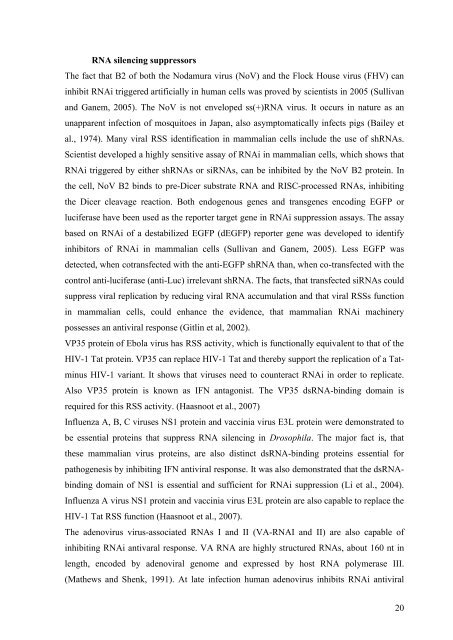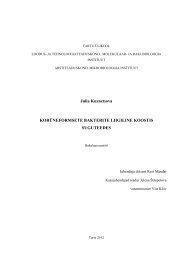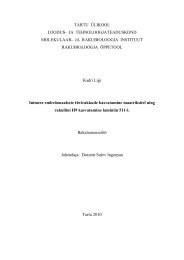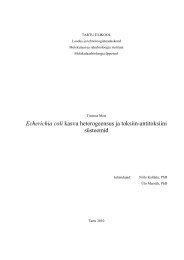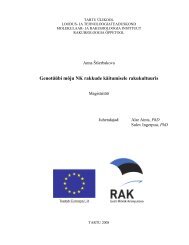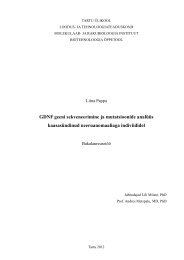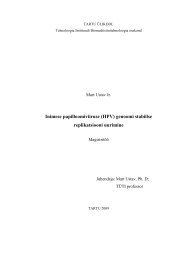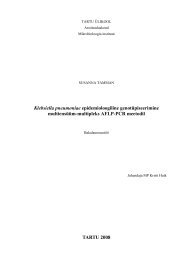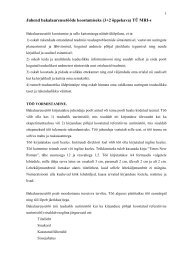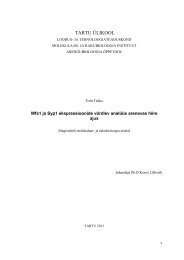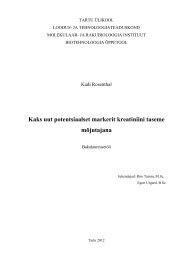Viruses and RNA interference in mammalian cells
Viruses and RNA interference in mammalian cells
Viruses and RNA interference in mammalian cells
Create successful ePaper yourself
Turn your PDF publications into a flip-book with our unique Google optimized e-Paper software.
<strong>RNA</strong> silenc<strong>in</strong>g suppressors<br />
The fact that B2 of both the Nodamura virus (NoV) <strong>and</strong> the Flock House virus (FHV) can<br />
<strong>in</strong>hibit <strong>RNA</strong>i triggered artificially <strong>in</strong> human <strong>cells</strong> was proved by scientists <strong>in</strong> 2005 (Sullivan<br />
<strong>and</strong> Ganem, 2005). The NoV is not enveloped ss(+)<strong>RNA</strong> virus. It occurs <strong>in</strong> nature as an<br />
unapparent <strong>in</strong>fection of mosquitoes <strong>in</strong> Japan, also asymptomatically <strong>in</strong>fects pigs (Bailey et<br />
al., 1974). Many viral RSS identification <strong>in</strong> <strong>mammalian</strong> <strong>cells</strong> <strong>in</strong>clude the use of sh<strong>RNA</strong>s.<br />
Scientist developed a highly sensitive assay of <strong>RNA</strong>i <strong>in</strong> <strong>mammalian</strong> <strong>cells</strong>, which shows that<br />
<strong>RNA</strong>i triggered by either sh<strong>RNA</strong>s or si<strong>RNA</strong>s, can be <strong>in</strong>hibited by the NoV B2 prote<strong>in</strong>. In<br />
the cell, NoV B2 b<strong>in</strong>ds to pre-Dicer substrate <strong>RNA</strong> <strong>and</strong> RISC-processed <strong>RNA</strong>s, <strong>in</strong>hibit<strong>in</strong>g<br />
the Dicer cleavage reaction. Both endogenous genes <strong>and</strong> transgenes encod<strong>in</strong>g EGFP or<br />
luciferase have been used as the reporter target gene <strong>in</strong> <strong>RNA</strong>i suppression assays. The assay<br />
based on <strong>RNA</strong>i of a destabilized EGFP (dEGFP) reporter gene was developed to identify<br />
<strong>in</strong>hibitors of <strong>RNA</strong>i <strong>in</strong> <strong>mammalian</strong> <strong>cells</strong> (Sullivan <strong>and</strong> Ganem, 2005). Less EGFP was<br />
detected, when cotransfected with the anti-EGFP sh<strong>RNA</strong> than, when co-transfected with the<br />
control anti-luciferase (anti-Luc) irrelevant sh<strong>RNA</strong>. The facts, that transfected si<strong>RNA</strong>s could<br />
suppress viral replication by reduc<strong>in</strong>g viral <strong>RNA</strong> accumulation <strong>and</strong> that viral RSSs function<br />
<strong>in</strong> <strong>mammalian</strong> <strong>cells</strong>, could enhance the evidence, that <strong>mammalian</strong> <strong>RNA</strong>i mach<strong>in</strong>ery<br />
possesses an antiviral response (Gitl<strong>in</strong> et al, 2002).<br />
VP35 prote<strong>in</strong> of Ebola virus has RSS activity, which is functionally equivalent to that of the<br />
HIV-1 Tat prote<strong>in</strong>. VP35 can replace HIV-1 Tat <strong>and</strong> thereby support the replication of a Tatm<strong>in</strong>us<br />
HIV-1 variant. It shows that viruses need to counteract <strong>RNA</strong>i <strong>in</strong> order to replicate.<br />
Also VP35 prote<strong>in</strong> is known as IFN antagonist. The VP35 ds<strong>RNA</strong>-b<strong>in</strong>d<strong>in</strong>g doma<strong>in</strong> is<br />
required for this RSS activity. (Haasnoot et al., 2007)<br />
Influenza A, B, C viruses NS1 prote<strong>in</strong> <strong>and</strong> vacc<strong>in</strong>ia virus E3L prote<strong>in</strong> were demonstrated to<br />
be essential prote<strong>in</strong>s that suppress <strong>RNA</strong> silenc<strong>in</strong>g <strong>in</strong> Drosophila. The major fact is, that<br />
these <strong>mammalian</strong> virus prote<strong>in</strong>s, are also dist<strong>in</strong>ct ds<strong>RNA</strong>-b<strong>in</strong>d<strong>in</strong>g prote<strong>in</strong>s essential for<br />
pathogenesis by <strong>in</strong>hibit<strong>in</strong>g IFN antiviral response. It was also demonstrated that the ds<strong>RNA</strong>b<strong>in</strong>d<strong>in</strong>g<br />
doma<strong>in</strong> of NS1 is essential <strong>and</strong> sufficient for <strong>RNA</strong>i suppression (Li et al., 2004).<br />
Influenza A virus NS1 prote<strong>in</strong> <strong>and</strong> vacc<strong>in</strong>ia virus E3L prote<strong>in</strong> are also capable to replace the<br />
HIV-1 Tat RSS function (Haasnoot et al., 2007).<br />
The adenovirus virus-associated <strong>RNA</strong>s I <strong>and</strong> II (VA-<strong>RNA</strong>I <strong>and</strong> II) are also capable of<br />
<strong>in</strong>hibit<strong>in</strong>g <strong>RNA</strong>i antivaral response. VA <strong>RNA</strong> are highly structured <strong>RNA</strong>s, about 160 nt <strong>in</strong><br />
length, encoded by adenoviral genome <strong>and</strong> expressed by host <strong>RNA</strong> polymerase III.<br />
(Mathews <strong>and</strong> Shenk, 1991). At late <strong>in</strong>fection human adenovirus <strong>in</strong>hibits <strong>RNA</strong>i antiviral<br />
20


